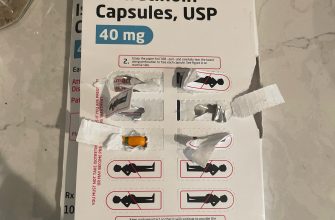If you are considering Topamax (topiramate) for managing bipolar disorder symptoms, it’s vital to consult a healthcare professional. This anticonvulsant medication has gained attention for its potential to stabilize mood swings and reduce episodes of mania and depression.
Research indicates that Topamax may help enhance mood stability due to its effects on neurotransmitter systems. Patients often report fewer mood fluctuations, making it a noteworthy option in bipolar treatment plans. It’s key to discuss your specific symptoms and treatment history with your doctor to determine if Topamax is suitable for you.
Monitor for potential side effects, which can include cognitive impairment, weight loss, and changes in mood. Regular check-ins with your healthcare provider can help track your progress and address any concerns. Combining medication with therapy offers a comprehensive approach to managing bipolar disorder.
- Topamax and Its Role in Managing Bipolar Disorder
- Understanding Topamax: Mechanism of Action in Bipolar Disorder
- Clinical Studies: Efficacy of Topamax for Bipolar Symptoms
- Study Findings
- Dose Recommendations
- Topamax Dosage Guidelines for Bipolar Disorder Treatment
- Potential Side Effects of Topamax in Bipolar Patients
- Physical Side Effects
- Weight Changes and Metabolic Effects
- Comparing Topamax with Other Mood Stabilizers for Bipolar Disorder
Topamax and Its Role in Managing Bipolar Disorder
Topamax, or topiramate, has gained recognition for its use in treating bipolar disorder, particularly in managing mood stabilization. Clinicians often prescribe it as an adjunct therapy alongside traditional mood stabilizers, such as lithium or valproate. Its mechanism of action involves enhancing inhibitory neurotransmission while inhibiting excitatory pathways, which contributes to mood regulation.
Research shows that Topamax can reduce the frequency and severity of mood episodes in patients experiencing bipolar disorder. Studies indicate that significant improvements have been noted in manic and depressive symptoms in some individuals. The medication is well-tolerated by many, with a lower risk of weight gain compared to other mood stabilizers. This aspect particularly appeals to patients who are concerned about the potential side effects of weight fluctuations.
When prescribing Topamax, doctors consider individual patient profiles, including health history and specific symptoms. Regular monitoring ensures that any side effects, such as cognitive impacts or possible kidney stones, are addressed promptly. Dosages typically start low and gradually increase, promoting an easier adjustment period for patients.
Patients might find that Topamax not only aids in mood regulation but also enhances cognitive functions, which can be affected during depressive states. This dual benefit supports the notion that managing bipolar disorder effectively involves a multifaceted approach tailored to each individual’s needs.
If you are exploring treatment options for bipolar disorder, consult with a healthcare professional about the possibility of incorporating Topamax into your treatment plan. This collaborative approach can lead to optimal outcomes and improved quality of life.
Understanding Topamax: Mechanism of Action in Bipolar Disorder
Topamax, or topiramate, acts primarily as a stabilizing agent for mood disorders, including bipolar disorder. It modulates neurotransmitter activity, which helps to regulate mood swings. By inhibiting the carbonic anhydrase enzyme, Topamax alters the levels of gamma-aminobutyric acid (GABA) and glutamate. This action promotes a calming effect on the nervous system, reducing the excitability associated with manic episodes.
The drug also interacts with various ion channels, affecting sodium currents and calcium channels. This modulation contributes to its anticonvulsant properties, making it effective in mood stabilization. Research indicates that this mechanism can help in minimizing the frequency and severity of mood episodes in individuals with bipolar disorder.
Topamax’s unique ability to impact multiple pathways enhances its role as an adjunctive treatment. Clinicians often recommend it for patients who may not respond sufficiently to traditional mood stabilizers. Monitoring for side effects, such as cognitive changes or weight loss, remains crucial during treatment to ensure optimal outcomes.
In summary, the multifaceted action of Topamax provides significant benefits for managing bipolar disorder. Understanding its mechanisms helps in tailoring treatments for individual patient needs, promoting better mental health. Always consult with a healthcare provider for personalized guidance and adjustments to your treatment plan.
Clinical Studies: Efficacy of Topamax for Bipolar Symptoms
Topamax (topiramate) demonstrates potential in alleviating symptoms of bipolar disorder. Clinical studies report its capacity to reduce manic and depressive episodes, contributing to mood stabilization. Research shows that patients treated with Topamax exhibit decreased severity of symptoms, leading to improved overall functioning.
Study Findings
A randomized controlled trial published in a prominent psychiatric journal indicated that participants receiving Topamax experienced a significant reduction in manic symptoms compared to the placebo group. The mean change in the Young Mania Rating Scale (YMRS) scores highlighted this improvement, showcasing Topamax’s role in managing acute episodes effectively.
Dose Recommendations
Optimal dosing for Topamax varies among individuals. Clinicians often start with a low dose, gradually increasing to a target range of 200-400 mg per day, depending on the patient’s response and tolerability. Monitoring for side effects is crucial, as some patients report cognitive or neurological effects. Adjusting the dosage can help mitigate these issues while ensuring symptom relief.
Topamax Dosage Guidelines for Bipolar Disorder Treatment
For adults, the initial dosage of Topamax (topiramate) typically begins at 25 mg once daily. It is essential to monitor the patient’s response and tolerance during the first week. After this initial period, titrate the dose gradually.
Common titration recommendations include:
| Week | Dosage Increase | Total Weekly Dose |
|---|---|---|
| 1 | 25 mg | 25 mg |
| 2 | 25 mg | 50 mg |
| 3 | 50 mg | 100 mg |
| 4 and beyond | 25-50 mg | Up to 400 mg |
It is crucial to adjust the dosage based on individual response. For maintenance therapy, the effective range is usually between 100 mg and 400 mg per day. Higher doses may be necessary for some patients but should be approached cautiously due to potential side effects.
Monitor for side effects such as cognitive impairment, dizziness, or metabolic acidosis during the titration process. Regular follow-ups help assess efficacy and safety throughout treatment.
Renal dosage adjustment is recommended for patients with impaired renal function. Physicians should always evaluate the patient’s specific situation, considering other medications and health conditions.
Potential Side Effects of Topamax in Bipolar Patients
Monitor for cognitive side effects, such as difficulty concentrating or memory problems. Patients may experience confusion or a sense of mental fog. If these symptoms arise, consult your healthcare provider for possible adjustments to the dosage.
Physical Side Effects
Topamax might cause dizziness, fatigue, or drowsiness. These can impact daily activities, so it’s wise to assess tolerance, especially when starting treatment. Report any severe or persistent symptoms to a doctor.
Weight Changes and Metabolic Effects
Weight loss occurs in some patients taking Topamax. While this might benefit certain individuals, monitor for excessive loss. Additionally, check for metabolic acidosis, indicated by increased fatigue or rapid breathing. Regular blood tests can help track this condition.
Some patients report a tingling sensation in the fingers and toes, known as paresthesia. This side effect is typically mild but can become bothersome. Discussing this with a healthcare provider can lead to strategies for relief or alternative treatments.
Be aware of the risk of kidney stones associated with Topamax. Increasing fluid intake and regular screening can minimize this risk. Signs to watch for include severe back pain or blood in urine. Early detection of complications enhances management outcomes.
Discuss any side effects openly with your healthcare team. Adjusting the treatment plan might improve tolerability while maintaining benefits for managing bipolar disorder.
Comparing Topamax with Other Mood Stabilizers for Bipolar Disorder
Topamax (topiramate) presents a unique approach in the treatment of bipolar disorder when compared to traditional mood stabilizers like lithium and valproate. The following comparison highlights key aspects of Topamax alongside common alternatives.
- Mechanism of Action: Topamax primarily works by modulating neurotransmitter activity and inhibiting excitatory pathways. In contrast, lithium stabilizes mood through various mechanisms, including alterations in sodium transport and second messenger systems. Valproate primarily increases gamma-aminobutyric acid (GABA) levels, providing its stabilizing effects.
- Efficacy: Studies suggest that Topamax can reduce the frequency of mood episodes, particularly in patients experiencing rapid cycling. While less traditional, it has demonstrated effectiveness in individuals who show inadequate response to lithium or valproate. Lithium remains the gold standard for mood stabilization, particularly in manic episodes, with substantial long-term data supporting its use. Valproate is similar, showing promise in both manic and depressive episodes.
- Side Effects: Topamax can lead to cognitive side effects such as confusion and difficulty concentrating, along with weight loss. On the other hand, lithium may cause weight gain, thyroid dysfunction, and renal issues. Valproate is associated with hepatotoxicity and weight gain, which can be concerning for long-term use.
- Monitoring Requirements: Patients on lithium require regular blood tests to monitor serum levels, kidney function, and thyroid activity to prevent toxicity. Topamax does not require routine blood monitoring but should be used cautiously in those with kidney problems due to increased risk of kidney stones. Valproate also necessitates liver function tests to mitigate liver damage risks.
- Drug Interactions: Topamax may interact with oral contraceptives, potentially reducing their efficacy. Lithium has numerous interactions that can affect its levels and efficacy, requiring careful management. Valproate also poses a risk of interactions that may influence its metabolism.
- Patient Considerations: Topamax might be suitable for patients with comorbid conditions like obesity or migraine, leveraging its additional benefits. Lithium is preferred for long-term mood stabilization without the need for additional medications and is often effective in preventing suicidality. Valproate is an option for individuals evolving through different mood episodes but may require additional management of side effects.
In conclusion, while Topamax offers certain advantages, particularly for those who’ve not responded well to conventional treatments, assessing individual patient profiles and preferences remains crucial. Collaboration between patients and healthcare providers ensures optimal treatment strategies tailored for successful management of bipolar disorder.










